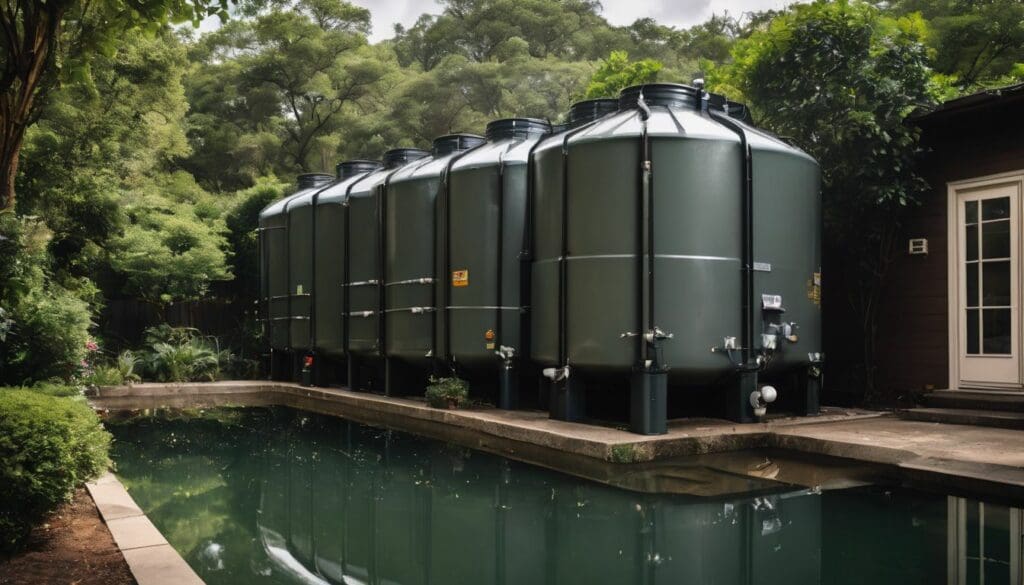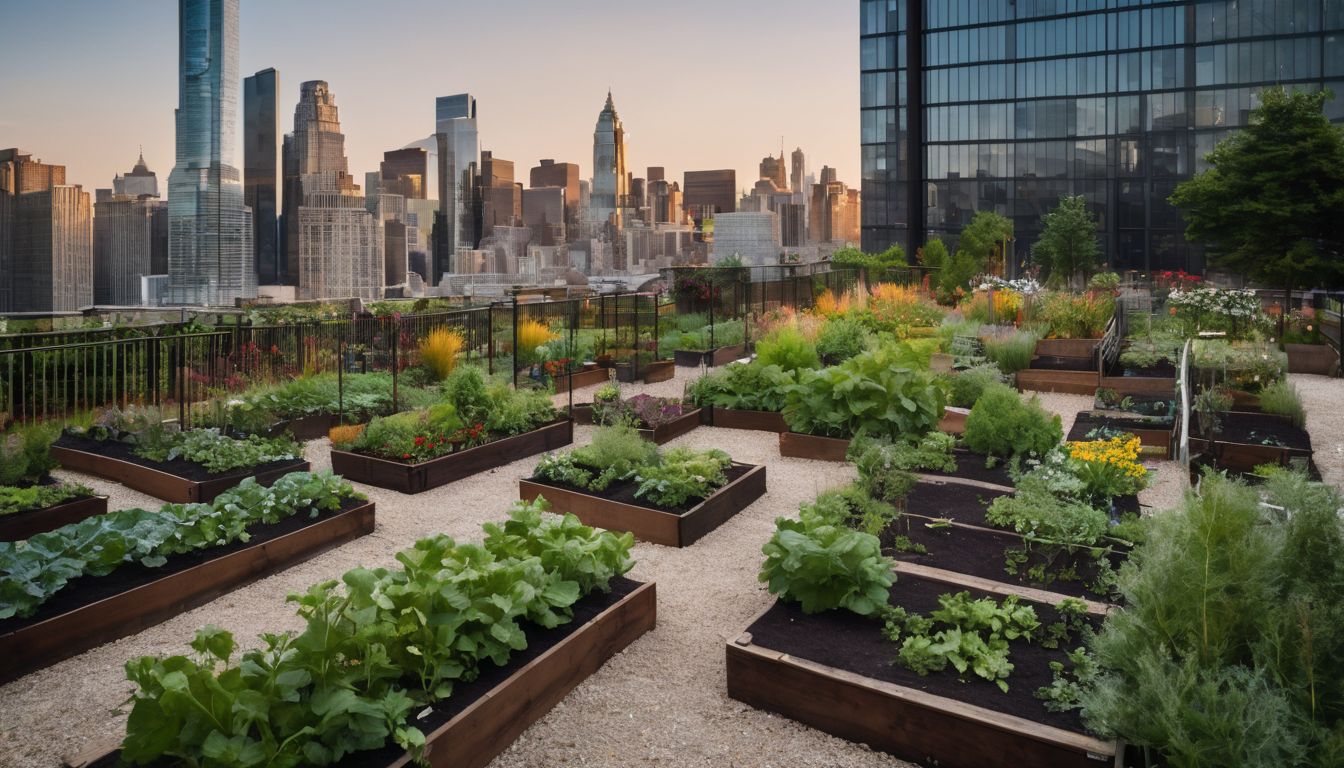As our towns grow, so does the need to manage water wisely. Did you know that collecting rainwater can significantly lower community water costs? This blog will walk you through setting up a local rainwater harvesting scheme, uniting neighbours for a greener future.
Let’s make every drop count!
Key Takeaways
- Community rainwater harvesting reduces reliance on municipal systems and cuts water costs, fostering greener neighbourhoods through sustainable practices.
- By collaborating with local authorities and adhering to regulations, communities can ensure their rainwater projects are both effective and compliant with the law.
- Innovative systems like smart technologies, green roofs, permeable pavements, and underground tanks maximise rainwater collection and contribute to urban sustainability.
- Public involvement in conservation projects is essential; education sessions and demonstration initiatives help raise awareness about the benefits of rainwater harvesting.
- Designing efficient rainwater harvesting systems requires careful planning that includes proper sizing of storage units, use of filtration devices, and consideration for excess rainfall management.
The Need for Urban Rainwater Harvesting
Urban rainwater harvesting is essential for sustainable water management in communities, providing benefits such as reducing demand on the public water supply and preventing urban flooding.
It promotes conservation and sustainability, making it a crucial aspect of community development.
Benefits for the community
Rainwater harvesting offers a trove of advantages that directly bolster community well-being. It reduces dependence on municipal water systems, cutting costs for both individuals and local governments.
Sustainable water management becomes a reality as rainwater catchment systems alleviate pressure on public utilities during peak demands in dry seasons. Cleaner, greener neighbourhoods emerge when communities collectively embrace these environmentally friendly practices.
Harvested rainwater can be channelled into landscaping and gardening, promoting lush urban green spaces without straining potable water supplies. Community engagement in constructing and maintaining these systems fosters a sense of unity and empowerment; residents take greater pride in their shared environment through active participation.
Moreover, the practical experience gained from such projects translates into invaluable skills for sustainable living which participants can carry forward into other areas of life.
Sustainability and conservation
Sustainability and conservation practices are essential for ensuring the long-term success of community rainwater harvesting projects. By implementing these initiatives, communities can effectively manage their water resources, reduce strain on municipal supplies, and contribute to environmental protection.
Conservation efforts also play a key role in preserving ecosystems and supporting biodiversity.
Community engagement in water conservation is vital for the success of sustainability projects. Through public demonstration projects and education initiatives, individuals can learn about small-scale water harvesting techniques and infrastructure development.
By collaborating with city planners and building community capacity through training programs, urban areas can work together to design effective rainwater collection systems and storage solutions.
Promoting Awareness and Community Engagement
Engaging the community in water conservation projects is crucial for the success of rainwater harvesting initiatives. From hosting demonstration projects to educating the public about sustainable water practices, community involvement plays a key role in promoting awareness and transforming urban areas into more water-resilient communities.
Demonstration projects
Demonstration projects play a crucial role in promoting awareness and educating the community about rainwater harvesting. They provide practical examples of how water conservation can be integrated into daily life, sparking interest and engagement.
- Hosting workshops where community members can learn about various rainwater collection techniques, empowering them to implement small-scale water harvesting solutions at their homes.
- Collaborating with local schools to set up demonstration projects within their premises, educating students about the importance of sustainable water management and inspiring them to advocate for conservation in their communities.
- Showcasing successful rainwater harvesting systems in public spaces such as parks or community centers, demonstrating the feasibility and benefits of these initiatives to city planners and officials.
- Organising guided tours of existing rainwater harvesting installations within the community, allowing residents to witness firsthand the positive impact of such projects and fostering a sense of collective responsibility for water conservation efforts.
Community education
Community education plays a crucial role in raising awareness about the benefits of rainwater harvesting. By promoting workshops and information sessions, individuals can learn about small-scale water harvesting techniques and how they contribute to urban water planning.
Community-based water harvesting initiatives empower people to take an active role in conserving water, fostering collaboration with city planners and supporting sustainable urban development.
Involving local schools and community organisations in demonstration projects fosters a sense of ownership and responsibility towards water conservation efforts. These actions contribute to community capacity building, empowering individuals to actively engage in community-based water conservation projects through knowledge sharing and practical application.
Designing Sustainable Rainwater Harvesting Systems
Designing sustainable rainwater harvesting systems is crucial in urban areas to effectively capture and store rainwater for community use. Techniques such as using green roofs, permeable pavements, and underground tanks can help maximise water collection and storage.
Importance in urban areas
Rainwater harvesting is crucial in urban areas to alleviate pressure on municipal water supplies and reduce the risk of flooding. Designing efficient systems ensures sustainable water management, benefitting the community by providing a local, reliable supply of water for non-potable uses like irrigation and washing.
Effective rainwater harvesting also contributes to mitigating urban heat island effects and enhancing biodiversity, fostering healthier and more resilient cities.
Implementing rainwater harvesting in urban areas supports sustainability efforts while creating a sense of community empowerment through active participation in environmental conservation.
Effective design techniques
In urban areas, effective design techniques for rainwater harvesting systems can help maximise water conservation efforts and sustainability. Here are some important considerations when designing sustainable rainwater harvesting systems:
- Proper sizing of storage tanks to ensure adequate capacity for collected rainwater.
- Installation of filtration systems to remove debris and pollutants from harvested water.
- Use of first – flush diverters to prevent the initial runoff from contaminating stored water.
- Incorporation of overflow outlets to manage excess water during heavy rainfall.
- Integration of gravity – fed distribution systems to minimise the need for pumps.
- Utilisation of durable materials for long-lasting infrastructure.
Overcoming Legal and Regulatory Hurdles
Understanding the laws and regulations surrounding rainwater harvesting is crucial for a successful community project. Finding solutions to legal and regulatory hurdles can ensure that the project meets all requirements and avoids any potential issues in the future.
Understanding laws and regulations
Municipal laws and regulations govern rainwater harvesting projects in urban areas. In some regions, permits may be required for installation of rainwater harvesting systems, while others may have specific guidelines regarding the size and location of storage tanks.
It’s essential to research local legislation pertaining to water conservation initiatives before implementing a community-based project.
To navigate legal requirements effectively, seek guidance from local authorities or environmental agencies, ensuring compliance with all necessary regulations. Community engagement can also help raise awareness around the importance of adhering to legal standards when planning and executing rainwater harvesting initiatives.
Finding solutions
Understanding local laws and regulations:
- Research the specific legal requirements for rainwater harvesting in your area.
- Consult with local authorities to ensure compliance with regulations.
- Engage with community leaders to gain their support for the project.
- Form partnerships with relevant organisations and individuals who can help navigate legal hurdles.
- Consult with professionals experienced in rainwater harvesting to guide you through the process.
- Seek advice on innovative techniques that can address legal and regulatory challenges.
Innovations in Rainwater Harvesting Technology
From smart systems to green roofs, there are various innovative technologies that can be implemented in community rainwater harvesting projects. These modern solutions offer efficient and effective ways to collect and store rainwater for sustainable use within urban areas.
Smart systems
Smart rainwater harvesting systems utilise advanced technology to efficiently collect and store rainwater. These systems can incorporate sensors to monitor water levels, ensuring optimal usage and preventing waste.
Additionally, smart systems can be integrated with automated filtration and purification processes, providing clean water for various community needs.
These innovative solutions are essential for maximising the benefits of rainwater harvesting while minimising environmental impact. By embracing smart systems, communities can demonstrate a commitment to sustainability and conservation, setting a positive example for future projects.
Green roofs
Green roofs offer an innovative solution for urban rainwater harvesting. By incorporating vegetation on building rooftops, green roofs help to capture and store rainwater, reducing runoff and easing the burden on existing drainage systems.
These eco-friendly installations not only provide an effective water conservation method but also contribute to improving air quality, creating wildlife habitats, and enhancing the overall aesthetics of urban spaces.
The implementation of green roofs in a community-based water harvesting project can serve as a practical demonstration of sustainable living and environmental stewardship. With their ability to absorb and retain rainwater, green roofs play a vital role in sustainable water management while promoting community engagement in small-scale water harvesting initiatives.
Permeable pavements
Permeable pavements allow rainwater to filter through the surface, reducing runoff and recharging groundwater supplies. Using materials like porous concrete or paving blocks with open areas enables water to pass through and be absorbed into the ground, preventing flooding and erosion.
In urban areas, permeable pavements can play a crucial role in managing stormwater and improving water quality by filtering out pollutants. These sustainable solutions offer environmentally conscious communities a practical way to contribute to water conservation efforts while also enhancing the aesthetics of their surroundings.
Underground tanks
Transitioning from permeable pavements to underground tanks, these storage solutions play a crucial role in community rainwater harvesting projects. Installing underground tanks provides a space-saving and discreet method for storing harvested rainwater.
These systems help prevent excess water runoff, ensuring that precious rainwater is efficiently collected and stored for future use. Additionally, underground tanks contribute to sustainable water management by reducing the strain on municipal water supplies and providing a reliable source of water for various community needs.
With their innovative design and practicality, underground tanks are an essential component of small-scale and large-scale water conservation initiatives. Their discreet nature makes them an ideal solution for urban settings where space may be limited, allowing communities to effectively harness the benefits of rainwater harvesting without compromising on aesthetics or functionality.
Conclusion
In conclusion, community rainwater harvesting projects offer a sustainable solution to urban water challenges. Engaging the community in such initiatives promotes awareness and active participation.
By designing and implementing innovative water harvesting systems, communities can effectively address water conservation while promoting a greener environment. Taking steps towards organising a community-based rainwater harvesting project is vital for creating a more sustainable future for all.
FAQs
1. What is a Community Rainwater Harvesting Project?
A Community Rainwater Harvesting Project involves designing and implementing water harvesting systems to conserve and wisely use rainwater in local communities.
2. How can we organise a successful water conservation project in our community?
To organise an effective community-based water harvesting initiative, you should engage with the community for support, plan small-scale demonstration projects for water conservation, and choose the right water storage solutions.
3. Why is it important to involve the community in rainwater harvesting projects?
Community engagement in water projects ensures that everyone understands the benefits of conserving water, contributes ideas for system design, and helps maintain the project over time.
4. Can rainwater be stored effectively for community use?
Absolutely! With proper planning and implementation of suitable water storage solutions, harvested rainwater can be efficiently stored for various uses within a community’s daily life.





